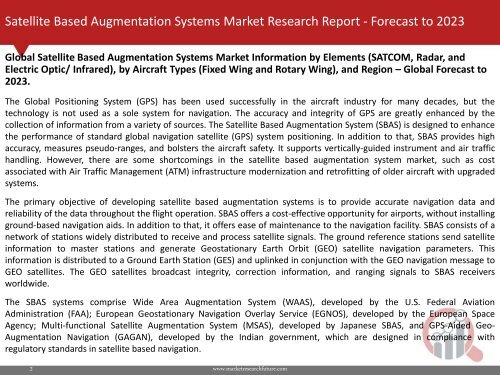Satellite Based Augmentation Systems Market
Global Satellite Based Augmentation Systems Market Information by Elements (SATCOM, Radar, and Electric Optic/ Infrared), by Aircraft Types (Fixed Wing and Rotary Wing), and Region – Global Forecast to 2023.
Global Satellite Based Augmentation Systems Market Information by Elements (SATCOM, Radar, and Electric Optic/ Infrared), by Aircraft Types (Fixed Wing and Rotary Wing), and Region – Global Forecast to 2023.
Create successful ePaper yourself
Turn your PDF publications into a flip-book with our unique Google optimized e-Paper software.
<strong>Satellite</strong> <strong>Based</strong> <strong>Augmentation</strong> <strong>Systems</strong> <strong>Market</strong> Research Report - Forecast to 2023<br />
Global <strong>Satellite</strong> <strong>Based</strong> <strong>Augmentation</strong> <strong>Systems</strong> <strong>Market</strong> Information by Elements (SATCOM, Radar, and<br />
Electric Optic/ Infrared), by Aircraft Types (Fixed Wing and Rotary Wing), and Region – Global Forecast to<br />
2023.<br />
The Global Positioning System (GPS) has been used successfully in the aircraft industry for many decades, but the<br />
technology is not used as a sole system for navigation. The accuracy and integrity of GPS are greatly enhanced by the<br />
collection of information from a variety of sources. The <strong>Satellite</strong> <strong>Based</strong> <strong>Augmentation</strong> System (SBAS) is designed to enhance<br />
the performance of standard global navigation satellite (GPS) system positioning. In addition to that, SBAS provides high<br />
accuracy, measures pseudo-ranges, and bolsters the aircraft safety. It supports vertically-guided instrument and air traffic<br />
handling. However, there are some shortcomings in the satellite based augmentation system market, such as cost<br />
associated with Air Traffic Management (ATM) infrastructure modernization and retrofitting of older aircraft with upgraded<br />
systems.<br />
The primary objective of developing satellite based augmentation systems is to provide accurate navigation data and<br />
reliability of the data throughout the flight operation. SBAS offers a cost-effective opportunity for airports, without installing<br />
ground-based navigation aids. In addition to that, it offers ease of maintenance to the navigation facility. SBAS consists of a<br />
network of stations widely distributed to receive and process satellite signals. The ground reference stations send satellite<br />
information to master stations and generate Geostationary Earth Orbit (GEO) satellite navigation parameters. This<br />
information is distributed to a Ground Earth Station (GES) and uplinked in conjunction with the GEO navigation message to<br />
GEO satellites. The GEO satellites broadcast integrity, correction information, and ranging signals to SBAS receivers<br />
worldwide.<br />
The SBAS systems comprise Wide Area <strong>Augmentation</strong> System (WAAS), developed by the U.S. Federal Aviation<br />
Administration (FAA); European Geostationary Navigation Overlay Service (EGNOS), developed by the European Space<br />
Agency; Multi-functional <strong>Satellite</strong> <strong>Augmentation</strong> System (MSAS), developed by Japanese SBAS, and GPS-Aided Geo-<br />
<strong>Augmentation</strong> Navigation (GAGAN), developed by the Indian government, which are designed in compliance with<br />
regulatory standards in satellite based navigation.<br />
2<br />
www.marketresearchfuture.com


















